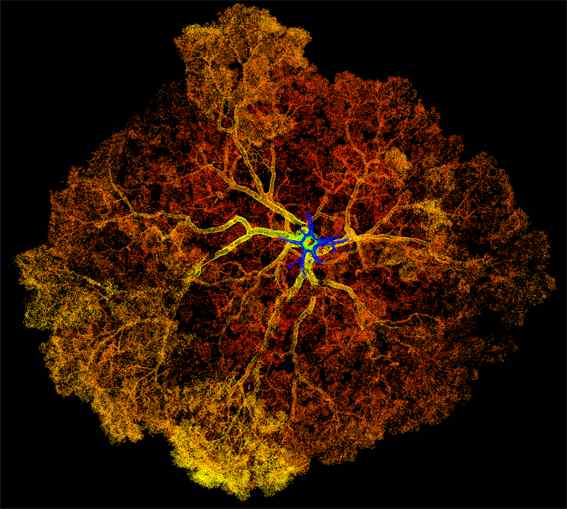Images of climate innovation
Trees of light
Nearly one million points of light make up this rainforest tree, which you see from directly below. How would you weigh a tree like this, without chopping it down? We are trying to tackle this problem by scanning trees with lasers to measure precisely their size and form. This will improve our understanding of how much carbon they store and their role in climate change.

The tree you see in this image is a Padouk, measured in central Gabon. It is over 40 metres tall, and weighs in at around 16 tonnes (not including the roots). Every dot of light in the image is a point where a flash of laser light was reflected from the tree's trunk, branches or leaves. There are exactly 871,779 such points, and they were coloured according to their height above the base of the tree. The image has an unusual perspective, in which you see vertically upwards through the trunk (it is not hollow, but the laser cannot penetrate inside the tree).
This technique is called terrestrial laser scanning (TLS), and is often used to survey buildings, quarries and archaeological sites. There is, however, a good reason to scan tropical trees. Around half of the biomass in a tree is carbon, which the tree has absorbed from the atmosphere. This makes forests useful for combatting climate change. However, estimating the amount of carbon stored by forests relies on good estimates of tree biomass without cutting trees down to weigh them!
TLS data like you see in this image provides a revolutionary new way to estimate tree biomass. We can use points lying on the surface of the tree trunk and its branches to create a 3D model of the tree. We then multiply the volume of wood in the model tree by the wood density (which varies according to species) to get biomass.
Entrant: Harry Carstairs , University of Edinburgh
Copyright: Andrew Burt
Funding: This project has received funding from the European Research Council (ERC) under the European Union’s Horizon 2020 research and innovation programme (grant agreement No 757526), as a Starting Grant awarded to Edward Mitchard.
Collaborators: Prof Edward Mitchard, Dr Iain McNicol, Chiara Aquino and Harry Carstairs (University of Edinburgh), Prof Mathias (Disney University) and Dr Andrew Burt (University College London), Gabonese partners CENAREST, ANPN, AGEOS, Rougier Gabon and Peruvian partners AIDER, SERFOR, PUCP and the community of Belgica.
Links
TLS tree visualisations: https://disneytls.blogspot.com/
https://harryfodex.blogspot.com/
www.mitchardgroup.wordpress.com/fodex